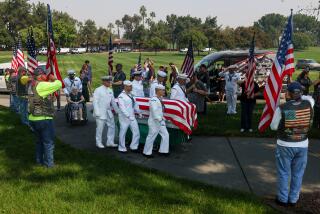Saluting a Modest WWII Hero
- Share via
A lowly Navy cook in World War II, Bill Pinckney never was one to brag.
But on Saturday, the Navy did the bragging for him, dedicating its latest ship to a sailor who earned the service’s second-highest honor for combat heroism but whose race kept him from rising in the ranks.
Before several thousand on the docks of Naval Base Ventura County, naval officials commissioned the Pinckney, a guided-missile destroyer said to be the Navy’s most technologically advanced warship.
It is only the 10th vessel named for an African American since the Navy’s founding in 1775.
Naval officials Saturday acknowledged the racial discrimination that once pervaded the service but pointed to the looming gray Pinckney at dockside to illustrate that it has been overcome.
In the crowd at Port Hueneme, a 75-year-old African American veteran named Bill Lewis agreed.
“The meaning of this is that we’ve come a long, long way,” said Lewis, who traveled with his family from Washington, D.C., for the event. “Back then, the only things they’d let us do would be handle ammo, serve chow and make beds. Now there are black admirals.”
Lewis served on the Enterprise, the aircraft carrier on which Pinckney earned the Navy Cross in 1942. Only four of the 3,968 Navy Crosses given during World War II went to black men.
During the Battle of Santa Cruz, Japanese bombs killed 44 sailors on Pinckney’s ship. Coming to after a blast that knocked him out, Pinckney hauled a wounded shipmate through flames in an ammunition-handling area. Sparks from a power cable knocked Pinckney out again, but he regained consciousness and managed to hoist the man up several decks before heading back into the flames on a futile search for other survivors.
Pinckney was badly burned and riddled with shrapnel. After leaving the Navy in 1946, he worked as a cook on Merchant Marine vessels. After 26 years, he retired to his native South Carolina.
Pinckney, who was so modest that no photos were taken at his wedding, died of cancer in 1976. But in many ways, his presence was felt at Saturday’s commissioning ceremony.
James Bagwell II -- the son of the sailor Pinckney saved -- sat on a platform of dignitaries that included Assistant Secretary of the Navy John Young, Rep. Elton Gallegly (R-Simi Valley), two admirals, assorted Navy brass and local officials.
Pinckney’s 83-year-old widow, Henrietta Pinckney, was there as well.
Helped from her wheelchair to the microphone by Robert M. Byron, the Pinckney’s commanding officer, she issued a clear order to the ship’s officers and crew: “Man your stations and bring this ship to life!”
With that, 334 sailors in their dress whites ran through aisles of folding chairs and up the ship’s gangplank, planting themselves at attention along the railings. As a Navy band launched into “Anchors Aweigh,” sirens sounded, a foghorn boomed, radar antennas twirled, guns fired, engines churned and white exhaust poured from the Pinckney’s smokestacks.
“These sailors you see manning the rail are the Pinckney,” Byron told the crowd, adding that they come from 46 states and more than half a dozen countries. “We are America.”
Byron called the billion-dollar ship “a complex and lethal machine.” He said it was the first U.S. destroyer to carry a robotic unit that could find and disable mines.
Equipped with the sophisticated Aegis antimissile system, it also is the first ship to make extensive use of off-the-shelf technology. That allows for quicker replacement of faulty parts and makes upgrading systems far easier, Byron said.
The Pinckney was built by Northrop Grumman at a shipyard in Pascagoula, Miss. In March, after a shakedown cruise to Charleston, S.C., tragedy hit the crew of the fledgling destroyer.
An observance was planned at Pinckney’s grave in nearby Beaufort. Five busloads of sailors were convoying to the cemetery when one of the buses collided head-on with a truck. Three crew members died and 70 were injured.
Eleven have not been able to report back to duty.
“It was so sad but it brought new meaning to the word ‘shipmates,’ ” said crew member Tamyca Ferrarie, 23, of Antigua. “We’re not just working together. We’re family.”
On hand for the commissioning were the parents of Alfred Concepcion of Maryland, one of the sailors who died in the crash. Back in South Carolina, Henrietta Pinckney attended a memorial for him and the others.
“These crew members are like my grandchildren,” she said Saturday.
Their ship’s motto -- a phrase the crew will shout when asked -- is “Proud to Serve.” It was taken from the words Pinckney uttered whenever he was asked to recount his heroism in the Navy.
“He wouldn’t say much about it,” Henrietta Pinckney said. “He’d just tear up.”
The Pinckney will be based in San Diego. Its future assignments are unknown but there is at least one certainty: The ship’s cooks will never serve beets.
Pinckney detested beets and Byron, the commander of his namesake ship, has banned them forever.
“It was an easy call,” he said.
More to Read
Sign up for Essential California
The most important California stories and recommendations in your inbox every morning.
You may occasionally receive promotional content from the Los Angeles Times.











